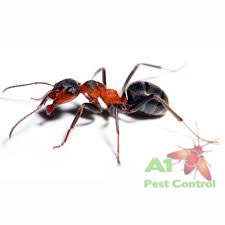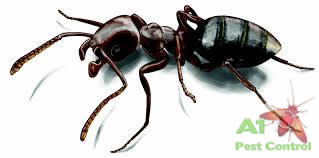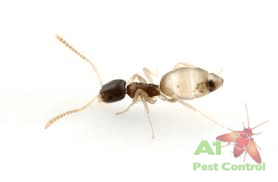All About Sugar Feeding Ants
- Small bodied, cloudy type of black ant
- Pointed gaster
- Small Single node (or petiole) which is hidden (compare this to the black house ant which has a visible node)
- 12 segments on its antenna
- No antenna ending in a club shape
- Pale colours on all of its tarsi
- One worker size
White-Footed House Ant

Sub-Family: DolichoderinaeCommon Name:Black House AntScientific Name:Ochetellus glaberMain Points:
- A small, intensely black ant
- This ant has a prominent node (patiole) which is a distinguishing feature from the white-footed house ant
- This ant is slightly smaller and stockier than the white-footed house ant

Ghost Ant
Sub-family:Dolichoderinae
Common name: Ghost ant
Scientific name: Tapinoma melanocephalum
Key Points
·
The small size is usually the key to identifying this ant·
This ant has 12-segmented antennae with the segments gradually thickening towards the tip·
Abdominal pedicel consists of one segment which is usually hidden from view dorsally by the gaster·
The petiole (node) is absent·
Gaster has four segments upon its upper surface
Ghost Ants

Key biology
The workers from the Ghost Ant species are incredibly tiny (only measuring around 1.5mm) and usually they are of a uniform size. They are hard to see due to their minute size and pale colour.
Their nests are readily formed outdoors or indoors however, they are opportunistic nesters; nesting in places that are often only viable for a few days or weeks as a nest. Indoors they are known to colonise voids within walls or other spaces beneath structures such as cabinetry and baseboards.
The working ants have a habit of erratically and rapidly running when they are disturbed. They are known to be quiet fond of honeydew and tend honeydew-feeding insects. This species of ant is generally found in the warmer and more humid climates although there are other species within this genus that are also found throughout the rest of Oz.
Food preferences
They feed on sugary liquids (exhibited by their common habit of tending to aphids and bugs on domestic plants).
Size
Approx. 1.5 mm
Ants can be a huge hassle when they come out in force, ring us up on 0417 251 911 and we’ll come sort out that ant issue ASAP! We are open to last minute quotes and bookings as well.
“Ants are often just seen as a nuisance but they can become a real pest if left untended for too long! Don’t risk an infestation and get us to exterminate them!” – Bruce Gow
Argentine Ant
Sub-family:Dolichoderinae
Common Name: Argentine Ant
Scientific Name: Linepithema Humile
Main Points:
·
The Argentine ant is similar to some Iridomyrmex spp. In body shape and color, but it has more teeth on the mandibles, a more tear drop shaped head (the widest point well above the eyes) the eyes are placed relatively lower on the front of the head·
It has 5-8 large teeth on the mandibles and 5 to 13 smaller denticles·
Resembles the white-footed house ant but is light brown in color·
Lacks a strong smell when crushed
Argentine Ant

Key Biology
The Argentine ant originally hails from South America and is limited to the southern area of Australia. Infestations by Argentine ants can become very serious due to the fact that mated queens disperse only a small distance on foot from the nest with a contingent of workers.
Their colonies therefore develop to be continuous and enormous as they get to a point where they have hundreds of queens and literally millions of workers. They can, through large colonies accompanied by rapid recruitment, get to the point where they have a monopoly on food sources before any other species can find them, they’re also capable of overwhelming other species that could’ve found them first.
Even if you have cupboards that are very secure they might still become victim to these apt marauders, refrigerators are also not guaranteed ant proof. Due to the massive size of their colonies and the structure they employ, management can be intricate. You can reduce their numbers by removing food sources however; this is generally not a method to completely guarantee their extermination. The Argentine ant has been declared a pest but former government control measures have been largely abandoned as it is now known to be established in a massive variety of areas.
Food preferences:
Sugary liquids (hence common habit of tending aphis and bugs on domestic plants)
Size
They measure approx. 2.5 mm
An Argentine ant infestation can become quite ugly when they grow so rapidly. Contact us before they take control of your home and steal the food off of your table. Ring us on 0417 251 911.
“Let us take care of your pest problem! We love getting down and dirty and showing those little buggers why they shouldn’t come back to your lovely home!” – Bruce Gow
Carpenter Ant
Sub-family:Formicinae
Common Name: Carpenter Ant
Scientific Name: Camponotus spp.
Main Points:
·Variable in colour – from black to dark brown to brownish orange
·Has a smooth, evenly rounded thorax
·Large in size
·Distinct single node on the petiole (pedicel)
·Mandibles have 5-8 teeth
·Polymorphic (multiple worker sizes)
Carpenter Ant

Key biology
The Carpenter Ant is quite large and found across all of Australia. They are commonly found to nest in decaying and moistened wood, although they do on occasion nest in soil.
Sometimes they can be found co-habiting with other social insects such as termites as well as other ant species. They’ve been found to be scavengers as well as predators and will collect plant secretions and also tend to plant-sucking insects such as aphis or mealy bugs for honeydew. They are most active at night-time when they forage.
Food preferences
Sugary liquids, as found with other ‘sugar feeding ants’ and therefore have a tendency to tend aphids and bugs on plants.
Size
Approx. 2.5 mm
Ring us on 0417 251 911 and we can sort out any ant altercation you might have!
“No ant is too much of a challenge for us; our staff is very well trained and don’t mind getting down and dirty to destroy some ants!” – Bruce Gow
Hairy Ant
Sub-family:Formicinae
Common Name: Hairy Ant
Scientific Name: Paratrechina longicornis
Main Points:
·
Hair ants have extremely long 12-segmented antennae which lack a club·
Single node on the pedicel·
Legs are unusually long relative to their body size·
There are many long, coarse, scattered hairs over their body
Hairy Ant

The Hairy Ant is known to form large colonies and are commonly found within open soil or beneath rocks and other objects.
They are found mostly in Eastern as well as Northern Australia yet most activity is recorded in the warmer areas. The worker ants scurry rapidly as well as erratically when disturbed (this gives the ants their other name ‘native crazy ant’).
This species is commonly quite easily identified due to the fact that they move so erratically when distraught. This coupled with the fact that they have long antennae and legs. They often forage far away from the nest which makes it difficult to manage a Hairy Ant infestation.
Food preferences
Sugary liquids (this attributes to their tendency to tend aphids and bugs on plants) with variations during seasons they tend to favour high-protein foods and diets during the summer over sugary foods.
Size
Between 1.2-2.5 mm
Finding a pest controller than knows how to handle a tricky ant infestation is the hardest part and now that you’ve found us that problem is solved! Ring us up on 0417 251 911 for a no hassles quote or a quick last minute appointment.
“We won’t try to hassle you or confuse you into getting treatments you don’t need. We’re a happy to get down to taking care of your pest problem!” – Bruce Gow
